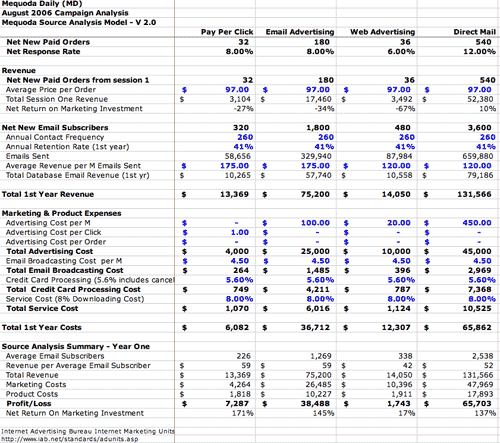Paid media programs balance your Internet marketing system
While patience is a required virtue for earned media programs, paid media programs offer the Mequoda Marketing System operator the opportunity for quick results with a reasonable ROI (return on investment). Each of these programs involves finding and buying traffic by spending money to buy advertising, leads or lists.
The ability to use many sources to build circulation and repeat the same basic process over and over allows Mequoda system operators to become better and better at acquiring more and more customers (active email subscribers) at lower and lower costs per new subscriber.
For example, when we launched Blue Dolphin Magazines in 2001, our initial cost per new email subscriber was about $21 via direct mail. Over time, our marketing team drove that cost per new email subscriber down to $4.35. They also found many other sources of new subscribers, some of which produced new active email subscribers for 25 cents or less. While our 25 cent subscribers did not spend as much per subscriber as our direct mail subscribers, they did produce an average first year ROI (return on investment) of 900 percent, with an average spending of $2.25 per subscriber.
While there are more than a dozen paid sources that can be used to successfully drive website traffic, build email circulation and sell information products, we’ll concentrate on four for this report.
Basic Paid Media Sources for Building Email Circulation
- Pay Per Click Advertising (PPC)
- Email Advertising
- Website Advertising
- Direct Mail
The Mequoda Source Analysis Model is shown above, with comparison source analysis for the four sources we’re explaining in this section. They include PPC, Email Advertising, Website Advertising and Direct Mail. Full explanations follow below. Download the model to see our numbers, which includes a blank spreadsheet for you to fill in your own numbers.
Pay Per Click Advertising (PPC)
While most research shows that a top organic search ranking will generate about 50% more clicks than a paid listing, a paid listing can be bought today—assuming you have a relevant offer that gets clicked. (Google ranks paid listing based on their CTR (click-thru-rate and their maximum bid per click.) PPC advertising also offers the advantage of letting the publisher control where the click goes. This allows the publisher to have Google traffic enter the site on a Rapid Conversion Landing Page where conversion rates to email subscriptions are about 3X higher than traffic that enters on an organic conversion page (home, topic or article page).
[text_ad]
Like all paid sources, cost per new email subscriber must meet your criteria for acceptable cost per new email subscriber. Assuming a $1.00 CPC and an 8 percent conversion rate to net email subscription, with an additional 8 percent of gross (unconfirmed) new email subscribers converting to a $97 paid offer, you’d be acquiring net new email subscribers for $12.50 and getting $9.70 of your $12.50 back almost immediately.
CPC Key Metrics
- 4,000 Clicks @ $1.00 per click = $4,000 in CPC advertising costs
- 320 new email subscribers at a cost of $12.50 per new subscriber
- 32 new $97 product buyers = $3,104 in immediate revenue (-27% ROI)
- $59 in first year spending per email subscriber = $13,369 (171% ROI)
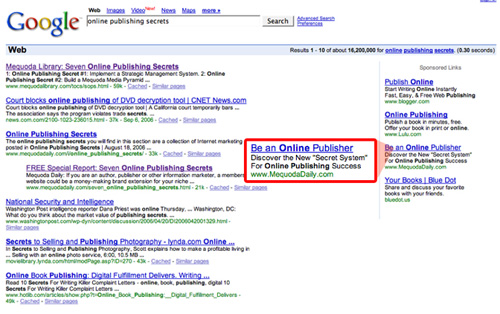
Email Advertising
Not surprisingly, other publishers’ email newsletters are a great source of new subscribers for your email newsletter. Before they subscribe to your email newsletter they’ve already demonstrated that they will subscribe to someone else’s email newsletters and click on advertising in that newsletter.
Most email newsletter publishers charge a flat fee to run your advertisement in their newsletter that is based, at least roughly, on a CPM (Cost per M, or thousand). The real cost per M impressions you’re paying is actually higher because only about half of emails sent will actually be opened and read if you have a high quality email newsletter (open rates for lower quality newsletters will be lower).
Still, the numbers may work well enough to meet your allowable cost per order. Let’s assume 12 percent of the arrivals to your RCLP (Rapid Conversion Landing Page) subscribe to your email newsletter and 8 percent of gross (unconfirmed) new subscribers immediately buy a $97 product.
Email Advertising Key Metrics:
- 250,000 emails sent with about 50% opened and a 6% CTR to your RCLP
- $25,000 advertising cost assuming $100 CPM emails sent
- 1,800 new email subscribers at a cost of $13.89 per new subscriber
- 180 new $97 product buyers = $17,460 in immediate revenue (-34% ROI)
- $59 in first year spending per email subscriber = $75,200 (145% ROI)
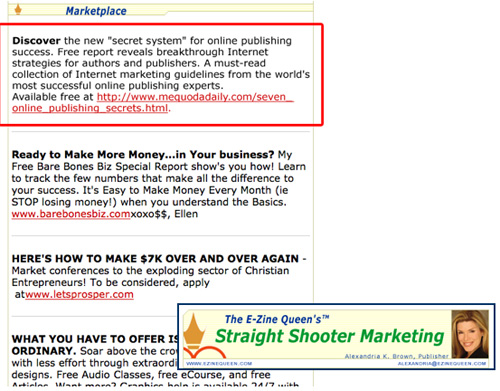
Website Advertising
Website advertising also offers the ability for someone to click directly to your Rapid Conversion Landing Page (RCLP), subscribe to your email newsletter and then be up-sold to a paid product.
Again, most websites charge a flat fee for a period of time that is based on some implied number of impressions. Larger websites and website advertising networks will actually charge for the number of impressions delivered on a CPM basis.
[text_ad]
Let’s assume you can buy website advertising $20 CPM impressions with a 9.6 percent net conversion to email subscriber and 6 percent of gross new subscribers buy a $97 product.
Website Advertising Key Metrics:
- 500,000 website impressions and a 1% CTR to your RCLP
- $10,000 advertising cost assuming $20 CPM
- 480 new email subscribers at a cost of $20.83 per new subscriber
- 36 new $97 product buyers = $3,492 in immediate revenue (-67% ROI)
- $42 in first year spending per email subscriber = $14,050 (17% ROI)
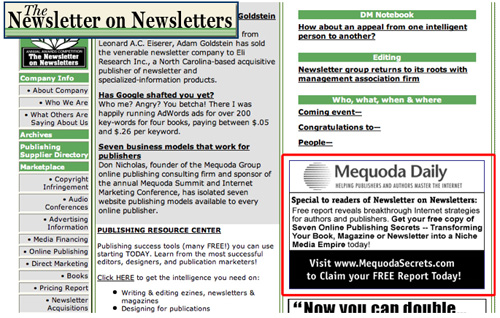
Direct Mail
While direct mail ROI may be less than other sources of new email subscribers, they are also often the most valuable in terms of annual spending per subscriber. Couple that with the ability to mail larger volumes to lists that may not be reachable thru online media and you have an interesting and little used method of driving website traffic, building email circulation, and selling information products.
Direct mail arrivals to your Rapid Conversion Landing Page (RCLP) will convert at the highest rate of any source we’ve measured ranging from 35 to 95 percent. For this example let’s assume a 72 percent net conversion rate to the email newsletter with 12 percent of gross (unconfirmed) new subscribers buying a $97 product.
Direct Mail Advertising Key Metrics:
- 100,000 direct mail post cards sent with 5% coming to your RCLP
- $45,000 advertising cost assuming $450 CPM
- 3,600 new email subscribers at a cost of $12.50 per new subscriber
- 540 new $97 product buyers = $52,380 in immediate revenue (10% ROI)
- $52 in first year spending per email subscriber = $131,566 (137% ROI)
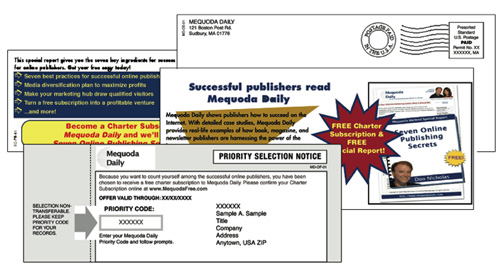
Phase 4: Monetizing Customer Relationships
Up until Phase 4 (some of which connects tightly to Phases 2 and 3 using the Up Sell Order Flow), we’ve been mostly spending money to set up our system and build email circulation. The real pay-off in a Mequoda Marketing System comes over time as system operators communicate with email subscribers about offers for paid information products that will help them solve their business and personal problems and live better lives.
The email newsletter and its visible staff become trusted advisors on the topic being covered and the website network becomes a first-choice resource for information that the user trusts. Sales efforts from the editors for many users are not viewed as advertising, but as additional valuable content on the topic.
The Mequoda Research Team has documented five primary channels of communication between the online publishing team and their users that result in information products being sold. We’ll cover all five in this report.
Five Channels for Monetizing Customer Relationships
- Editorial Email
- Promotional Email
- Direct Mail
- Telemarketing
- FAX Marketing
Editorial Email
Text and graphical “advertising” in editorial emails can generate $20 to $60 per M emails sent for consumer email newsletters and $50 to $200 per M for B2B newsletters. The email newsletters can feature a single story or multiple story summaries that lead back to the Internet Hub. Advertising for individual products link to Sales Letter Landing Pages and other ads link to bookstore or marketplace pages that list multiple information products by subject or media platform.
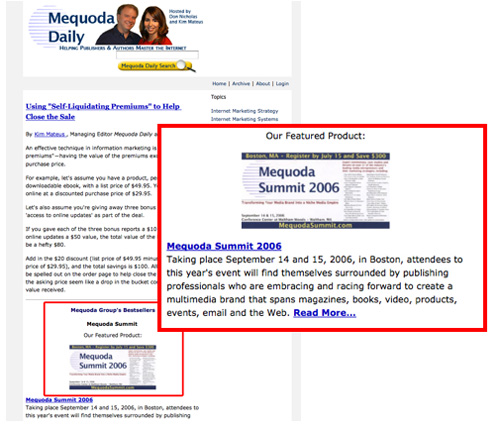
Promotional Email
Promotional emails will typically generate 60 to 80 percent of all Mequoda Marketing System revenues. Experienced online publishers recommend that no more than 40 to 50 percent of all emails be promotional in nature and that the remaining emails be editorial in nature and can include some “advertisements” for the publisher’s relevant information products.
As with direct mail, longer email sales letter work best. University Health Publishing’s CEO Rodney Friedman reported at a recent Mequoda gathering that they had doubled response with a 40-page email promotion versus the 4-page control. In cyber-space long copy costs little more than short and has the power to convince skeptical users that your product is worth the price.
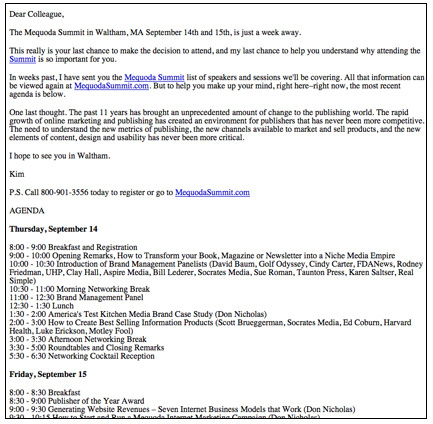
Direct Mail
While many publishers report that they cannot mail profitably to email subscribers who are non-buyers, they universally agree that once an email subscriber buys a physical product and surrenders a postal address for delivery purposes, those customers become very profitable direct mail buyers.
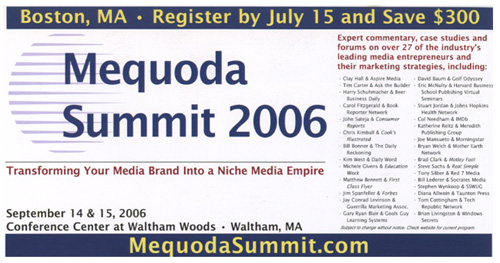
Telemarketing
Like direct mail, many publishers report that a free email subscriber must take some action beyond subscribing to their email newsletter to warrant the cost of a telemarketing call. B2B publishers, in particular, report that telemarketing is a very productive source of sales for conferences, events and membership websites.
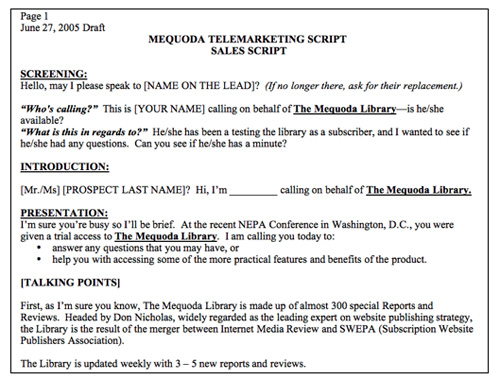
FAX Marketing
Some B2B publishers continue to find FAX marketing to known buyers an effective way to sell higher-priced products—event marketing being the most common usage.
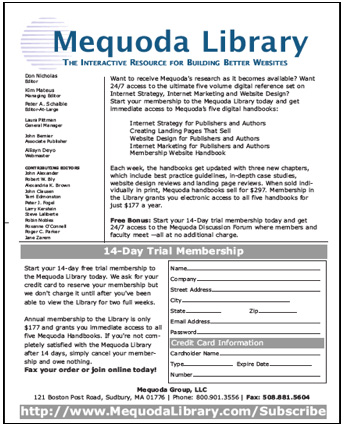
This article is just one in a very popular series called How to Start and Run an Effective Internet Marketing System. To read the rest of the series, see below:
